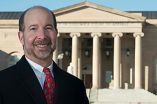(Press-News.org) Scientists at Griffith University's Institute for Glycomics and The Saban Research Institute of Children's Hospital Los Angeles have discovered a critical weakness in leukaemic cells, which may pave the way to new treatments.
The research team has demonstrated that leukaemic cells can be eradicated by removing a carbohydrate modification displayed on the cell's surface.
Director of Griffith University's Institute for Glycomics, Professor Mark von Itzstein is the Australian team leader. He said the discovery is an important advance against leukaemia, a cancer of malignant white blood cells that multiply uncontrollably. Acute lymphoblastic leukaemia (ALL) is the most common childhood cancer.
"We have found that the leukaemic cell has an altered cell surface carbohydrate decoration compared to normal cells and this also conveys resistance to drug treatment," Professor von Itzstein said.
"We have now shown that with the removal of this carbohydrate alteration the cells die."
Professors Nora Heisterkamp and John Groffen, leaders of the US-based team, Professor von Itzstein and their colleagues have published their research findings in the latest edition of the internationally acclaimed Journal of Experimental Medicine.
Professor von Itzstein said the research could lead to new ways to fight the disease, particularly where it has become treatment resistant.
"Up until 40 years ago, only one child in five survived ALL", but advances in chemotherapy have changed that outcome and now nearly 80 percent of children with ALL will be cured," Professor von Itzstein said.
"For the remaining 20 percent, however, the disease returns necessitating additional rounds of intensive chemotherapy. Unfortunately, most relapsed patients die within one year because their cancer cells are resistant to chemotherapy.
"In the future, we hope that this novel, structural approach to treating ALL may offer an effective treatment option for children battling drug-resistant forms of the disease."
Professor von Itzstein said the discovery had been made possible only through a unique sharing of research expertise.
"These results are the culmination of an international collaboration that commenced only a few years ago when Professor Groffen spent study leave in the Institute for Glycomics on Griffith's Gold Coast Campus," Professor von Itzstein said.
"It has been a wonderful opportunity to combine the US team's internationally acclaimed expertise in leukaemia with our own expertise in carbohydrate science.
"By exploiting this 'Achilles heel' in these leukaemic cells, our collaborative research efforts are now focused on the development of a new type of drug therapy that targets this carbohydrate modification."
Patron of the Institute for Glycomics Leukaemia project in Australia, Air Chief Marshal Angus Houston AC, AFC (Ret'd), said he was delighted with this latest advance.
"These new findings provide the groundwork for a new fight against this terrible disease," he said.
###
About Griffith University's Institute for Glycomics:
Based at Griffith University's Gold Coast Campus, research at the Institute for Glycomics involves the study of the carbohydrates and carbohydrate-recognising proteins in various biological systems, and the design of novel drugs and vaccines to treat or prevent clinically important diseases. This approach presents an exciting therapeutic platform for the control of a wide-range of medical conditions such as a variety of cancers, infectious diseases, inflammation and immune disorders. The Institute is the only one of its kind in Australia and only one of six in the world.
For more information visit http://www.griffith.edu.au/science-aviation/institute-glycomics
Breakthrough in battle against leukemia
Griffith University researchers find cancer cell weakness
2013-03-13
ELSE PRESS RELEASES FROM THIS DATE:
It's all in the way we move
2013-03-13
When, how and why modern humans first stood up and walked on two legs is considered to be one of the greatest missing links in our evolutionary history. Scientists have gone to the far ends of the earth – and the wonderful creatures in it - to look for answers to why we walk the way we walk.
In the latest such search, researchers from the University of the Witwatersrand in Johannesburg (South Africa) have taken a closer look at bipedal kangaroos and wallabies and how they move compared to their cousin-marsupials, such as the quadrupedal Tasmanian wolf.
In an article ...
Paraffin encapsulated in beach sand material as a new way to store heat from the sun
2013-03-13
The search for sustainable new materials to store heat captured from the sun for release during the night has led scientists to a high-tech combination of paraffin wax and sand. Their report on the heat-storing capability of this microencapsulated sand appears in ACS Sustainable Chemistry & Engineering.
Benxia Li and colleagues explain the need for better materials that can store and release heat. These so-called "phase-change" materials" (PCMs) are essential, for instance, for storing heat from the sun for use in providing energy at night or during cloudy periods. PCMs ...
Doing business with a parrot
2013-03-13
This press release is available in German.
VIDEO:
Muffin and 13 other cockatoos showed the skills to wait and trade 'normal' for 'better' or 'more' nuts.
Click here for more information.
Waiting: a clever move!
In the 70ties, self-control of human infants was investigated using the prominent 'Stanford Marshmallow Experiment': the children were presented with a marshmallow and ...
Younger doctors more likely to train and work closer to home
2013-03-13
Younger doctors are more likely than older generations to train and work in the same region as their home before entering medical school. New research published in the Journal of the Royal Society of Medicine investigating the geographical mobility of UK-trained doctors, reveals that 36% attended a medical school in their home region. 34% of hospital consultants and GP partners settled in the same region as their home before entering medical school. The geographical distribution of doctors is an important factor in the equitable distribution of health services.
Trevor ...
Extreme water
2013-03-13
Earth is the only known planet that holds water in massive quantities and in all three phase states. But the earthly, omnipresent compound water has very unusual properties that become particularly evident when subjected to high pressure and high temperatures. In the latest issue of the Proceedings of the National Academy of Sciences (PNAS), a German-Finnish-French team published what happens when water is subjected to pressure and temperature conditions such as those found in the deep Earth.
At pressures above 22 MPa and temperatures above 374°C, beyond the critical ...
Surprising control over photoelectrons from a topological insulator
2013-03-13
Plain-looking but inherently strange crystalline materials called 3D topological insulators (TIs) are all the rage in materials science. Even at room temperature, a single chunk of TI is a good insulator in the bulk, yet behaves like a metal on its surface.
Researchers find TIs exciting partly because the electrons that flow swiftly across their surfaces are "spin polarized": the electron's spin is locked to its momentum, perpendicular to the direction of travel. These interesting electronic states promise many uses – some exotic, like observing never-before-seen fundamental ...
Evidence supports blocking immune response to enhance viral therapy against solid tumors
2013-03-13
Following several years of study, investigators have found more evidence that viral therapy to treat solid tumors can be enhanced by blocking the body's natural immune response.
Oncolytic viruses have shown promise as anticancer agents, with variations of the herpes simplex virus (HSV) among the most commonly used. However, many studies have shown that the effectiveness of viral therapy to eradicate tumors has not been as successful with patients as it has been in the lab. These results have led researchers to examine the body's immune system response to determine what ...
Bradley Hospital researchers find age-related changes in how autism affects the brain
2013-03-13
EAST PROVIDENCE, R.I. – Newly released findings from Bradley Hospital published in the Journal of the American Academy of Child & Adolescent Psychiatry have found that autism spectrum disorders (ASD) affect the brain activity of children and adults differently.
In the study, titled "Developmental Meta-Analysis of the Functional Neural Correlates of Autism Spectrum Disorders," Daniel Dickstein, M.D., FAAP, director of the Pediatric Mood, Imaging and Neurodevelopment Program at Bradley Hospital, found that autism-related changes in brain activity continue into adulthood. ...
Events in the future seem closer than those in the past
2013-03-13
We say that time flies, it marches on, it flows like a river — our descriptions of time are closely linked to our experiences of moving through space. Now, new research suggests that the illusions that influence how we perceive movement through space also influence our perception of time. The findings provide evidence that our experiences of space and time have even more in common than previously thought.
The research, conducted by psychological scientist Eugene Caruso of the University of Chicago Booth School of Business and colleagues, is published in Psychological ...
Study reveals 10 factors in wrongful conviction cases
2013-03-13
Why do innocent people go to jail in the United States every year for violent crimes they did not commit? It's a serious question representing the ultimate miscarriage of justice—taking away the freedom of a factually innocent person while also allowing the guilty person to remain free. The U.S. Department of Justice's National Institute of Justice (NIJ) wanted to learn answers to prevent wrongful convictions in the first place.
Jon B. Gould, J.D., Ph.D., a professor and the director of the Washington Institute for Public and International Affairs Research at American ...
LAST 30 PRESS RELEASES:
Tracing the quick synthesis of an industrially important catalyst
New software sheds light on cancer’s hidden genetic networks
UT Health San Antonio awarded $3 million in CPRIT grants to bolster cancer research and prevention efforts in South Texas
Third symposium spotlights global challenge of new contaminants in China’s fight against pollution
From straw to soil harmony: International team reveals how biochar supercharges carbon-smart farming
Myeloma: How AI is redrawing the map of cancer care
Manhattan E. Charurat, Ph.D., MHS invested as the Homer and Martha Gudelsky Distinguished Professor in Medicine at the University of Maryland School of Medicine
Insilico Medicine’s Pharma.AI Q4 Winter Launch Recap: Revolutionizing drug discovery with cutting-edge AI innovations, accelerating the path to pharmaceutical superintelligence
Nanoplastics have diet-dependent impacts on digestive system health
Brain neuron death occurs throughout life and increases with age, a natural human protein drug may halt neuron death in Alzheimer’s disease
SPIE and CLP announce the recipients of the 2025 Advanced Photonics Young Innovator Award
Lessons from the Caldor Fire’s Christmas Valley ‘Miracle’
Ant societies rose by trading individual protection for collective power
Research reveals how ancient viral DNA shapes early embryonic development
A molecular gatekeeper that controls protein synthesis
New ‘cloaking device’ concept to shield sensitive tech from magnetic fields
Researchers show impact of mountain building and climate change on alpine biodiversity
Study models the transition from Neanderthals to modern humans in Europe
University of Phoenix College of Doctoral Studies releases white paper on AI-driven skilling to reduce burnout and restore worker autonomy
AIs fail at the game of visual “telephone”
The levers for a sustainable food system
Potential changes in US homelessness by ending federal support for housing first programs
Vulnerability of large language models to prompt injection when providing medical advice
Researchers develop new system for high-energy-density, long-life, multi-electron transfer bromine-based flow batteries
Ending federal support for housing first programs could increase U.S. homelessness by 5% in one year, new JAMA study finds
New research uncovers molecular ‘safety switch’ shielding cancers from immune attack
Bacteria resisting viral infection can still sink carbon to ocean floor
Younger biological age may increase depression risk in older women during COVID-19
Bharat Innovates 2026 National Basecamp Showcases India’s Most Promising Deep-Tech Ventures
Here’s what determines whether your income level rises or falls
[Press-News.org] Breakthrough in battle against leukemiaGriffith University researchers find cancer cell weakness



